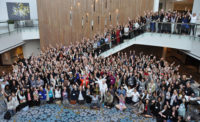Calls for Equity and Inclusion Echo Long After AIA Conference

During the 2018 AIA Conference in New York, more than 100 demonstrators gathered outside the Jacob K. Javits Convention Center for the Voices of Plurality flash mob.
Photo © Architectural Record

The flash mob at the AIA was organized by (from left to right) Pascale Sablan, Rosa Sheng, A.L. Hu, Julia Murphy, and Caroline James.
Photo © Architectural Record


In architecture, as in other fields, the #MeToo movement of the past year has prompted the profession to grapple with whispered rumors, deeply rooted biases, and longstanding inequalities, catalyzing a chorus of voices calling to make the field more equitable, and inclusive. And, if the political activity at the 2018 American Institute of Architects (AIA) Conference in New York this June was any indication, advocates are refusing to be ignored any longer.
“This is time for a revolution,” said 90-year-old Beverly Willis, FAIA, just days before the longtime activist for women in architecture took the stage as part of the Voices of Plurality flash mob at the AIA Conference. The demonstration was one of several official and unofficial events focused on equity and diversity, including AIA-organized panels on harassment-free workplaces, the Architecture Lobby’s National Think-In, and exhibitions on the history of activism in architecture (organized by ArchiteXX) and architects of the African diaspora (by S9 Architecture and the National Organization of Minority Architects). Yet despite the swell of conversation, building on decades of activism, many who spoke with record said they were tired of waiting for change from the top down.
“The AIA has many committees, and they’re doing many studies and making other slow-moving efforts aimed at minimizing this problem in the profession,” says Frances Halsband, FAIA, of Kliment Halsband Architects. “I think what all of us believe is, it has to be done faster.” Before the conference, Halsband circulated a petition that asked members of the College of Fellows to demand the AIA’s Code of Ethics be amended to specifically address discrimination, harassment, and abuse. “Amending the Code of Ethics is the key to change,” Halsband says. “It’s absolutely imperative we do it as soon as possible.” After gathering hundreds of signatures in just days, Halsband adapted the petition into a formal motion, which passed with near-unanimous support at this year’s AIA Business Meeting. The board of directors, which holds the power to change the Code of Ethics, will consider formalizing the amendments during their next meeting, in September.
While the fight for equal representation, pay, and respect has been going on for decades—it’s been a full 50 years since civil rights leader Whitney Young, Jr., implored architects to take an active role in creating a more just society, and some four decades since women began pushing for equality at an AIA conference in the 1970s—much of the recent activism stems from the “missing 32 percent,” a gap between the women who graduate from architecture school (about 50 percent) and those who get licensed (now about 20 percent but previously 18 percent, hence the missing 32). That statistic led to the formation of Equity by Design, within the San Francisco AIA, which works to identify and eliminate the pain points driving people from the field, no matter their identity.
The shift is away from the idea of equality—everyone gets the same resources—toward a framework that focuses on removing barriers to success and leveling the playing field. “We can’t say we’re inclusive when we only talk about one specific group,” says Rosa Sheng, FAIA, founding chair of Equity by Design.
A rising generation is also rejecting entrenched injustices and advocating for a more holistic balance between life and work. Boston-based designers Juliet Chun and Zhanina Boyadzhieva, both of Leers Weinzapfel Associates, created Girl UNinterrupted, a research project studying the challenges facing emerging professionals. The duo recently published their findings from a survey of 533 Boston designers and conversation series with women architecture leaders, and presented them at this year’s AIA Conference. The document blames professional dissatisfaction on a lack of transparency and on poor communication between leaders and early-career employees, especially about benefits, company culture, mentorship, and being heard. “Emerging professionals need to speak up. If there are things that you don’t agree with—it’s a matter of expressing your values, desires, and wants,” says Chun. As Carole Wedge, FAIA, says in an interview in their publication, “Don’t be a bystander.”
Frances Bronet, who this year became the first woman president of Pratt Institute in Brooklyn, sees the potential of the coming demographic shifts. “A lot of emerging professionals are going into leadership positions very soon,” she says. “They can start to make the changes that will better their practices and architecture in general.” In fact, AIA chief economist Kermit Baker estimates some 25,000 new positions will need to be filled in the field in the next decade, paving the way for a new generation.
Providing tomorrow’s practitioners equitable paths to leadership and strong role models is essential if the profession hopes to meet the challenges of the 21st century. It’s been “an exclusive club for many years, and it’s out of sync with the times,” Louise Braverman, FAIA, agreed after the flash mob outside of the Jacob K. Javits Convention Center. “It’s keeping the profession down. It’s 2018: old-school is not gonna cut it.”




